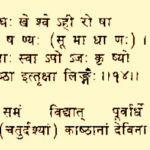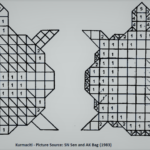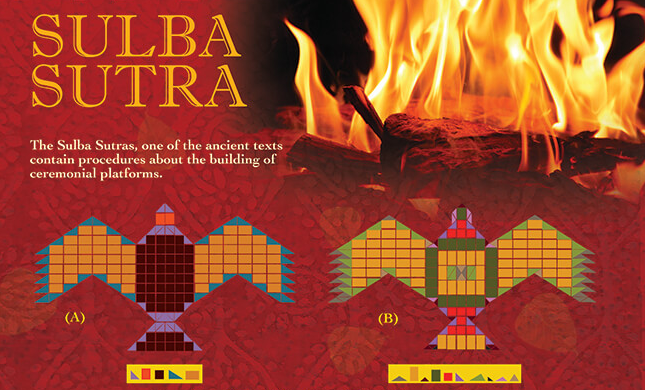
How great is the science which revealed itself in the Sulba, and how meagre is my intellect! I have aspired to cross the unconquerable ocean in a mere raft". -Bibhutibhushan Datta, Science of the Sulbas.
Summary
In this short introductory post, we share the motivation behind the study of Ganita in ancient Indian works such as Vedanga Jyotisha and Sulba Sutras, before delving deeper into the geometrical science of the Sulbas in Part-2. This self-study gives us a rough understanding of traditional Indic Engineering and its methods. We further develop these ideas in the third and final part and apply it toward solving challenging contemporary problems.
Introduction
The Sulbasutras are comprehensive reference manuals to plan, align, measure, compute, layout, and construct structurally stable Vedic Altars required for the proper performance of Yagnas. The Sulbas belong to the Srauta Sutra section of the Kalpasutras, which are one of the six Vedangas attached to the Vedas. The Sulbas provides the required spatial and directional parameters for constructing the altars while the time-keeping calculations in the Vedanga Jyotisha decide the temporal parameters of the Yagna. The position vector coordinates consisting of orientation, location, and time (dik-desa-kaala) can be decided using these texts.
Sulba primarily means measurement [1], which is done using the measuring cord called the Rajju, although sometimes these two terms are used interchangeably. An early Hindu term mentioned in the Sulba Sutras is Sulba Vijnana, roughly the ‘science of the Sulba’, measurement science, or the geometrical sciences [1], which also became known later as kshetraganita [2]. Part-2 has a more complete discussion of these terms.
Seven Sulba Sutras are available today, and the three earliest Sulbas are listed below (earlier first), noting that the dating of the early Sulba to 800 BCE is tentative and only provides the latest date when the Sulbas were compiled. The organization of these three Sulbas are given below [1].
Baudhayana Sulba Sutra
This is considered the world’s earliest systematic treatise on Geometrical Sciences, but like the Vedanga Jyotisha, contains pre-existing ideas from more ancient Vedic works that date back to the 2nd-3rd millennium or earlier. Interestingly, the pythagorean theorem is first stated by Baudhayana.
The Sulba content also serves as the oldest known reference text for Engineering.
Chapter 1: 116 sutras
Topics: measures, geometrical rules of altar construction, relative positions and magnitudes of the various Vedis.
Chapter 2: 86 sutras
Topics: spatial relations in the constructions of the agnis (Vedic fire altars),
and the construction of the two simplest agnis, i.e., Garhapatya and Chandas (Veda mantras replace bricks).
Chapter 3: 323 sutras
Topics: Seventeen different kamyagnis, which involve complex and highly specific constructions.
Apastamba Sulba Sutra
6 sections, 21 chapters and 223 sutras in total.
This work also discusses the methods of construction.
Katyayana Sulba Sutra
7 sections, 90 sutras. 48 verses.
The content is partly in sutra form and part verse. Additional topics include attributes of Sulba expertise, and the rules of ethical conduct for those involved in altar construction.
The other available Sulba works include those of Maanava, Maitraayana, Vaaraaha, and Vaadula.
Available commentaries on the three Sulbas (likely date: post Aryabhata)
BS: Dvarakanatha Yajva, Venkateshvara Dikshata
AS: Kapardiswami (before 1150 CE), Karavindaswami, Sundararaja (prior to 1600), Gopala
KS: Rama Bajapeya (1449 CE) who made new contributions and improved the accuracy of √2 up to 7 decimal places, and Mahidhara (1589 CE, Banaras, based on Rama’s work).
Why Study the Sulbas?
The Sulbasutras have been popular as a mathematical research area since the 19th century CE. There exist several works by acclaimed scholars that summarize the mathematical content and astronomical connections of the Sulba texts through books and video lectures, and can be found within the reference section at the end of the post. Here, we study the Sulba content to try and delineate an Indic approach to Engineering and where it differs from the western method.
Our primary references for this effort are the seminal 1932 work of Bibhutibhushan Datta on the Sulbas [1], the 1979 book of ancient Indian Geometry by Saraswati Amma [2], the 1997 publication of Kapila Vatsyayan’s work on Indic Art [3], and several other textual and non-textual resources. Bibhutibhushan Datta (who later became Swami Vidyaranya) and Saraswati Amma were Sanskrit scholars in addition to their mathematical expertise. Barring exceptions, scholarly works adopt a reductionist ‘secular mathematical’ view of the Sulbas, ignoring its Vedic basis as simply irrelevant, or dismissing it as pre-rational mystic rituals.
Questions
- What is the wrong with adopting such a Euro-centric approach? Why move toward an Indic perspective?
- What is the practical benefit of studying the content of such ancient Hindu texts?
The responses to these questions given by learned Indian scholars inspired us to ask similar questions of our own professional domain:
- Is there such a thing as a traditional Indic approach to Engineering? If so, what are the principles of this Indic Engineering Practice? How is it even relevant today?
We turn to Dharampal for answers.
Bharatiya Chitta and Kaala
In his writings [11], Dharampal explains the value and need for studying ancient Indian texts from an Indic perspective: “One understands others only from one’s own perspective. Attempts to live and think like the others, to transport oneself into the Chitta and Kaala of others, lead merely to delusion… In fact, the process of understanding the Indian Chitta and Kaala cannot possibly begin without some understanding of the vast corpus of literature that has formed the basis of Indian civilisation and regulated the actions and thoughts of the people of India for millennia…
...If we wish to affirm the validity of Indian consciousness, of Indian Chitta and Kaala, we can do so only by establishing the Indian way of life in the present-day world. And, this re-assertion of India in the present context is the major task today which Indian scholarship, Indian politics, Indian sciences and technologies, Indian arts, crafts and other diverse skills must accomplish. ”
Dharampal emphasizes the time-criticality and practical requirements of this task.
“what is urgently needed is not high scholarship, but a rough and ready comprehension of ourselves and the world. We need a direction, a vision, a conceptual basis, that is in consonance with the Indian Chitta and Kala, and through which we can proceed to understand the modern world and the modern times…”
Keeping this challenging goal in mind, we have studied the technical aspects of the Sulba Sutras not in isolation, but relative to and serving its primary objective.
Preliminaries
The overarching objective of the Sulba Sutras is to establish the proper construction of Vedic altars in order to ensure the correct performance of Yagna, which unites mankind to the devatas [4]. The keywords listed below give us a limited but useful idea of the Sanskrit non-translatables employed in this context of Yagna.
Agni: Fire altar constructed using layers of bricks of different types and dimensions.
Citi: A layer of Agni
Vedi: The raised area where the Yagna is performed, including the agni and where the participants are seated.
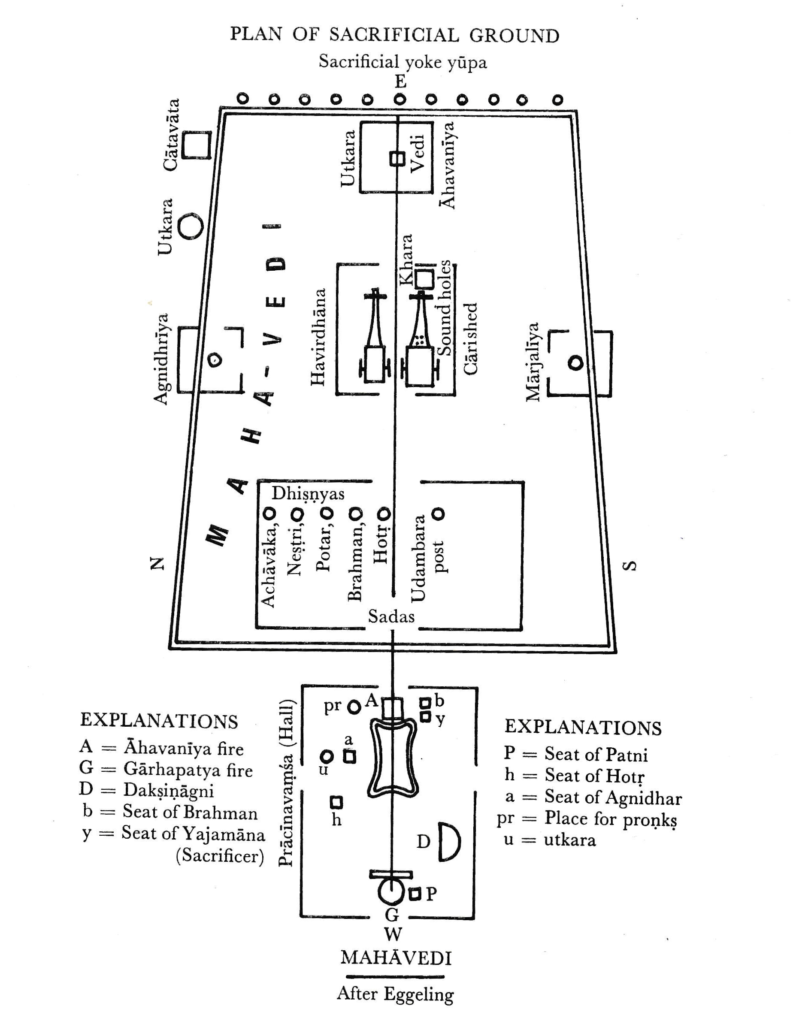
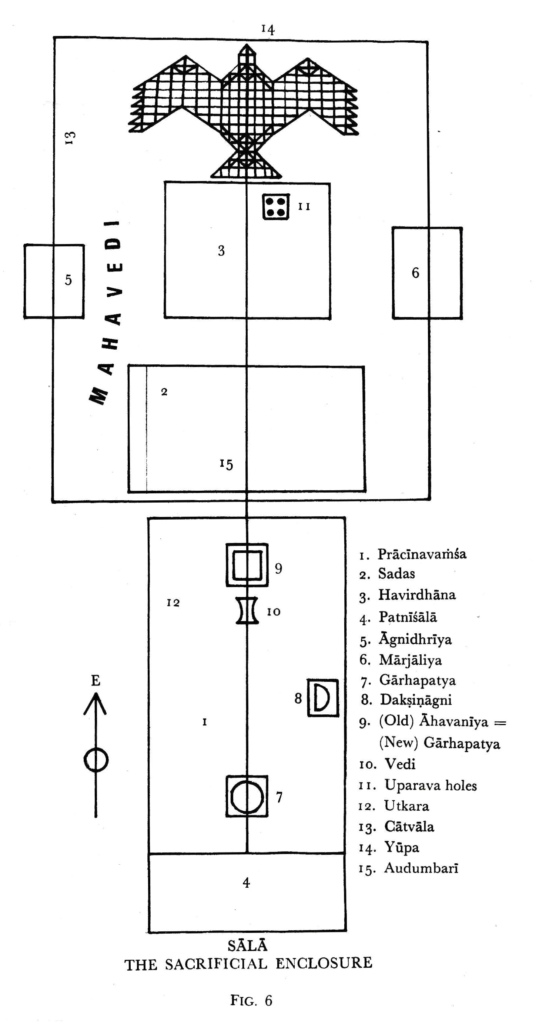
तत् कर्म यन्न बन्धाय विद्या सा या विमुक्तये।आयासायापरं कर्म विद्यान्या शिल्पनैपुण्यम्।।
The real ritual is that which does not bind, the real science is that which liberates. All other ritual fatigues, all other science is only skill in craft. (Kularnava Tantra 1.112)— Sampadananda Mishra (@Sampadananda) December 29, 2017
Indic Engineering Practice as Yagna
Integral Versus Fragmented Knowledge
The Vedic Cosmology is embedded in every aspect of the altar constructions. Every grain of sand, brick, citi, and the altars of various shapes correspond to some aspect of the cosmos. These correspondences or Bandhus bind the universe in an integral unity. Rajiv Malhotra coined this term in his book ‘Being Different [4]: “The integral unity of the whole manifests itself in the parts, and they in turn aspire to unite with the whole; this principle is reflected in every domain of dharmic knowledge, including philosophy, science, religion, ethics, spirituality, art, music, dance, education, literature, oral narratives, politics, marriage rituals, economics, and social structures. Each domain of dharmic knowledge is itself a jewel in Indra’s Net, and reflects all the others. In other words, the same underlying principles are represented in these specialties in different ways.”.
Prof. Subhash Kak in his path-breaking work [5] states that the agnicayana altars symbolize the universe; the five layers of the Ahavaniya represent the earth, space, and sky through the first, third, and fifth layer, with the intermediate layers linking these elements. He asserts that knowledge is gained through altar construction. The knowledge obtained through Yagna is integral and not fragmented since the traditional Indic approach is not to “disentangle and differentiate conceptually different entities & notions, but to realize their connections (bandhus) [5]”.
133.1)"(Q—You had once told us, "Each spot of the body is symbolical of an inner movement; there is there a world of subtle correspondences".. Why?)
Because the whole physical world is the symbol of universal movements. So our body is the symbol of our inner movements.."— Mohit Bansal (@Auro_Mere) January 6, 2018
For example, the circadian biological cycle is synced with earth’s rotational cycle through Ritam (from the Rig Veda, nature’s ordering principle [4]). The press release for the 2017 Nobel Prize in Physiology starts with “Life on Earth is adapted to the rotation of our planet“, and concludes with “indications that chronic misalignment between our lifestyle and the rhythm dictated by our inner timekeeper is associated with increased risk for various diseases.“. The deficiency in the inherently fragmented western approach is apparent in this ‘new’ finding based on inner and outer correspondences. In contrast, in ‘Being Different‘, Rajiv Malhotra gives examples of Ayurveda’s integral unity. Ayurveda, an Upaveda of the Vedas emphasizes the importance of adopting the right, sustainable lifestyle for an individual.
Science rooted in a vedic framework can lead to sustainable solutions to many such important problems. The Indic engineering system designed and built to work in harmony with Ritam will benefit both man and environment, while also serving a higher, transcendental objective. The traditional Indic practitioner would not look at his/her field in isolation but could draw inspiration, ideas and methods from seemingly unrelated disciplines, which in reality are interlinked knowledge systems that are integrally united [4].
Lacking this deeper dharmic unity, western attempts to unify separate fields of knowledge is evident in new-age ideas such as ‘combinatorial creativity‘, and the ‘generalized specialist’. Professional certifying examinations in the west tend to reward practitioners having a T-shaped skillset in the workplace and reduce the proportion of ‘one legged men in ass-kicking contests‘. Despite such efforts, the splintered view of knowledge, which tends to be profitable in the short-term, is not only dominant but gaining ground in western higher education, culminating in ‘fragmentversities‘.
Certitude and Uncertainty
Indic scholars have presented many more examples of such Bandhus in the altar construction: Kapila Vatsyayan [3] mentions that in certain constructions, there are 108,000 lokamprna bricks corresponding to the number of muhurtas in a basic 360-day Vedic year. There are 396 yajumati bricks in some constructions which corresponds to the 360 days + 36 intercalary days of a Vedic calendar. Similarly, certain Kamyagnis have a surface area of 108,000 (sq.) Angulas [5].
In the Chandasciti, Vedic mantras are considered equivalent to and replace the consecrated bricks, where the construction is no longer physical, but at the level of consciousness [12]. An altar of mantras is a representation of the Rig Veda. Correspondences are established using Ganita Sastra and Sulba Vijnana, resulting in accurate calculations and precise measurements. However, such decisive alignments and careful stacking of bricks do not signify a quest for an unnaturally perfect order. The altar construction reflects nature’s geometry that balances smoothness (certitude) and roughness (uncertainty).
The role of uncertainty is recognized and incorporated into the altar through the sprinkling of sand and interspersing the orderly chant of Vedic mantra with inarticulate sounds. Yagna combines order and chaos [4]. The amicable sharing of sacred space by doubt and surety suggests an early Indic grasp of the fallibility of the scientific claim, and the unavoidable imprecision in calculation and measurement. We can see the tangible value of this ‘bandhutva’ with uncertainty in the results of the Sulba sutras in part-2. On the other hand, without uncertainty, there can be no useful science. Engineering in the Sulbas also views uncertainty as an opportunity to innovate. This will be covered in part-3.
This 'concession' to fallibility is not a weakness, but a contributor to Bharata's dynamism and civilizational continuity through its demonstrated ability to continually reform and transform from within and be reborn. This is Bharata's own Natyam through the ages; a Yagna performed on India's sacred geography, its altar constructed on a cosmic level using bricks from Bharatiya Chitta and Kaala. Every Bharatiya who participates in this Yagna is transformed, thereby transforming the national consciousness.
It is imperative in science to doubt; it is absolutely necessary, for progress in science, to have uncertainty as a fundamental part of your inner nature. To make progress in understanding, we must remain modest and allow that we do not know. pic.twitter.com/BTjFUtb0C3
— Richard Feynman (@ProfFeynman) December 7, 2017
Sulba Vijnana: From Art to Engineering
Toward obtaining a more comprehensive view of the Sulba science, we learn from the art perspective of the Sulbas and Yagna presented by renowned art scholar Kapila Vatsyayan, and is summarized below. If Yagna is a basis for Indian art, architecture, and sciences, then the vijnana of the Sulbas will be reflected in all these fields, and the engineer will be able to learn a lot from such art.
- Elements of Geometry and Algebra emerge from the Bandhus, the system of correspondences established during the Yagna
The Indian way of viewing nature, and their inclination to look for Bandhus [4] is nicely captured by Vatsyayan ji when she states that “anything that is visible can have layers of meaning, and also has validity for itself… the visible is not just visible but is the very aid to the invisible.” During the Yagna, a link is created between finite and infinite, between the precisely measured that are defined by name and form (nama, rupa) and that beyond definition and the formless (pararupa and arupa).
Bandhus in the form of geometrical metaphors can be identified here. Fundamental geometric entities starting from a single ‘dimensionless’ point (Bindu), the one-dimensional line that emerges from a moving point, the two-dimensional figures such as triangle, square, and circle that emerge from moving lines, etc. are all symbols having multiple meanings. Sophisticated principles from the Vedas and Upanishads are contained within the circle and its geometrical properties [3]. Bindu also denotes a center or origin, and all notions of time and space are comprehended through it. Another Bandhu described by Vatsyayan ji is in the form of the botanical metaphor of the seed or Bija [3], which motivates Bija Ganita (algebra), the earliest notions of which are to be found in the geometrical methods of the Sulba Sutras.
Every math student in the world is replicating the first step of Vedic Yagna when they draw the perpendicular X-Y axes on graph paper, intersecting at the origin with the X-Y axis arrowhead pointing eastward. Vedic Altar construction begins by identifying the east-pointing E-W line (Praci) using the instrument Sanku [14]. The basic geometrical construction of the Sulbas is the perpendicular bisector, yielding the north-south line.
2. The geometrical and algebraic ideas that emerge from the Sulbas are transferred to the sacred Indian artforms.
Vatsyayan ji traces the methodology (viniyoga) of human movement evolved in Indian arts to its interconnections with the vidhi of the yagna. She notes the importance of trigonometry and geometry to science as well as art, and states that the system of solving linear equations by moving from one known to many unknowns represents both a mathematical and artistic understanding. This algebraic layer “gives the Indian arts the capacity to concretise the notions of the one and the many as also abstract and concrete, the measurable and beyond measure finite and infinite” [3]. Thus, Indic art reflects the findings of the Sulba Sutras. Kapila Vatsyayan remarks that a careful study of the Sulba Sutras can tell us exactly how those Sulba principles were transferred into the artistic domain.
In her award-winning research paper at the third Swadeshi Indology conference (Chennai 2017), danseuse and aerospace engineer Prakruti Prativadi has discussed Bharatanatyam as Yagna. She has reviewed the necessary conditions for a recital to qualify as a Bharatanatyam performance. When the sacred artistic recital is of high caliber and the audience too is receptive to the performance, the performer and the audience unite as participants in a Yagna [8]. "The purpose of Bharatanatyam is not only to produce an aesthetic effect but to transform the consciousness of the onlooker to experience the Paramatma through Rasa." [10]. The participants are thus reborn.
Ganita’s place value systems and Sanskrit itself are algebraic in nature [4]. In the decimal place value system, the value of a digit such as ‘1’ is variable and can be any integral power of 10 (1, 10, 10², 10³, …) and is fixed only when its place is specified. Similarly, a Sanskrit word or verse can have a whole range of meanings. The Sanskrit Pandit can narrow down the appropriate meaning depending on the context of usage [4]. A misunderstanding here can produce silly interpretations (e.g. “Beef in the Vedas“).
Professor Amartya Kumar Dutta at the Indian Statistical Institute in his excellent survey of ancient Ganita prior to the common era [13], quotes Swami Vivekananda on the decimal system. This quote by Swamiji highlights the integral unity of Ganita and Sanskrit: “… the ten numerals, the very cornerstone of all present civilization, were discovered in India, and are, in reality, Sanskrit words.”. Where does Sanskrit end and Ganita begin, and where does Ganita end and Sanskrit begin!
3. Engineering as an integral discipline emerges from Sulba Vijnana (with Ganita from Vedanga Jyotisha as pre-requisite).
From the artistic domain of Bharatanatyam, the connection can be made to Silpa Sastra and sacred architecture and sculpture: Vatsyayan ji quotes the renowned danseuse Balasaraswati who explains how a Bharatanatyam recital is structured like a great temple [3] affirming that both Indic art and sacred architecture are based on a system of correspondence established through Vedic yagna. Sulba Vijnana is used in the construction of Hindu Mandirs. The calculating expertise comes from Ganita, the science of computation. The Sulba Sutras along with Vedanga Jyotisha form the basis of Engineering as an integral discipline. Indian history is full of amazing feats of engineering that stand out for the harmony of construction with nature.
Let's have a Twitter thread to celebrate the outstanding Pushkarani's / Step wells/ Baoili's / Daav's / Baudi's / Kalyani's of India.
Please post the picture (after verifying) and mention the place and state name.Let me start with the magnificent Kalyani in Hampi, Karnataka. pic.twitter.com/NeJENinkJr
— Kiran Kumar S (@KiranKS) January 11, 2018
Reclaiming the Sacred Space
The present rupture [7] in India’s epistemological continuity has resulted in a significant number of Indian elites transporting themselves to live in the socially profitable Chitta and Kaala of the West [11]. The situation is dire. Many of us have lost the depth of insight available to our ancestors by limiting ourselves to living with this reductive, fragmented mindset. The Indic practitioner’s effortless and refined improvisation in-context while remaining anchored in the Raaga and Taala of Bharatiya Chitta and Kaala is achieved through Shraddha and Saadhana. Without this anchor, there is an overemphasis on text and theory over embodied knowing [4], with contextual ethics [4] giving way to moral relativism. The net result is a rootless, jarring remix of uninspiring engineering and myopic profiteering.
There are multiple paths to recovery, and we discuss one such path. As Dharampal pointed out [11], rather than weep over the lakhs of manuscripts that are lost to us, we can learn from what is already available. The several Sulba works, Jyotisha redactions, and the Natyasastra text, and the various commentaries, and dozens of books on these topics are all available online. By incorporating these Indic methods into our professional practice and daily life, we can slowly relocate our westernized selves back into India’s Chitta and Kaala.
A long and circuitous journey has to be undertaken by the hard-working Karthikeyas in order to return home to Shiva and obtain the Jnana-phala. Blessed are those Vinayakas who are already in the right space and time!
Understanding the principles of Indic art and dramaturgy can give engineering students a more rounded view of their discipline. Like a genuine Bharatanatyam performance, the sculpting of Devi’s Murthi, or constructing a Kovil/Mandir, Indic Engineering takes up a project as a sacred task that transforms the consciousness of the participants and end users, yielding sustainable, dharmic development. This goal can be achieved if the project is in harmony with Rta, accepting only shubh labh (as opposed to unbridled profit), with all the stakeholders functioning as an integrally united team based on the dharma of collaboration.
There is no I or U in team, but there must be IU.
The construction of Rama Sethu in the Ramayana forever serves as the ideal to emulate. Even the tiny squirrel that contributed its expertise to the Sethu was transformed by Sri Rama’s divine touch.

References:
(Partial list only. Full list will be shared along with Part-3).
- Bibhutibhushan Datta (Swami Vidyaranya). The Science Of The Sulba: A Study In Early Hindu Geometry. University of Calcutta. 1932.
- Saraswati Amma. Geometry in Ancient and Medieval India. Motilal Banarsidass Publishers. 1979.
- Kapila Vatsyayan. The Square and the Circle of the Indian Arts. Abhinav Publications. 1997.
- Rajiv Malhotra. Being Different: An Indian Challenge to Western Universalism. Harper Collins. 2011.
- Subhash Kak. The Astronomical Code of the Ṛgveda (Third Edition). 2011.
- Rajiv Malhotra. Indra’s Net: Defending Hinduism’s Philosophical Unity. Harper Collins. 2014.
- Kosla Vepa. The Origins of Astronomy, The Calendar, and Time (Second Edition). 2010.
- Prakruti Prativadi. Rasas in Bharatanatyam: First in a Series on Indian Aesthetics and Bharatanatyam. Creative Space. 2017.
- N.R.I Pathi. Dharmic Development. Andhra Cultural Portal. 2014.
- Prakruti Prativadi. The Bharatanāṭyaṃ Yajña. Swadeshi Indology-3 Information Handout. 2017.
- Dharampal. Collected Writings in 5 Volumes. Other India Press. 2000.
- John Price. Applied Geometry of the Sulba Sutras. Department of Mathematics, Maharishi University of Management, Iowa. 2000.
- Amartya Kumar Dutta. Was There Sophisticated Mathematics During Vedic Age? in ‘An anthology of disparate thoughts at a popular level‘. ISIREA, Kolkata, 2016.
- K. Ramasubramanian. The Origin and Growth of Mathematics in India. R C Gupta Award Lecture, IIT Bombay. 2010.
Acknowledgments:
Thanks to the ICP editor for his valuable suggestions and patiently reviewing this work.


